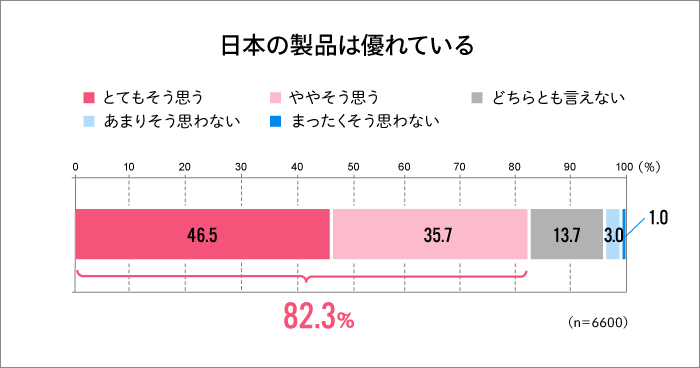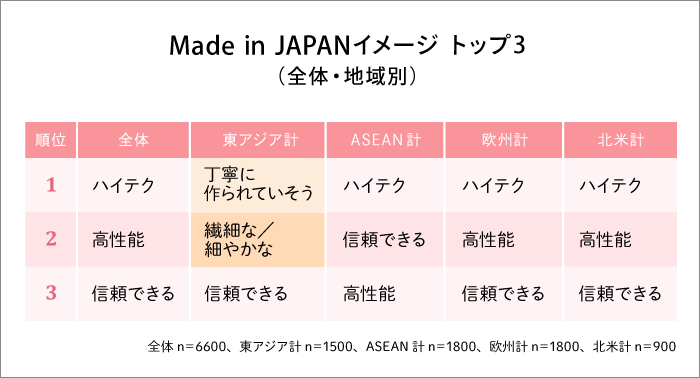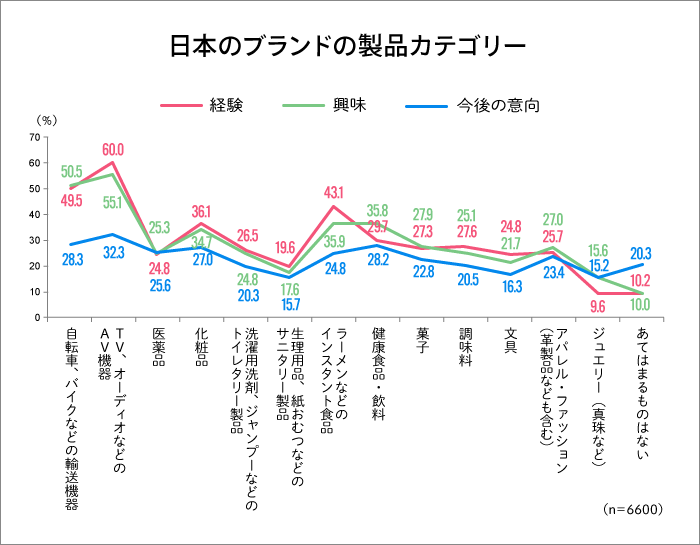In Part 3 of this series, we introduced how "shopping" ranks high among things people want to do in Japan. Walking through Ginza, you'll encounter many foreign tourists enjoying shopping. We also hear about gachapon becoming a hot topic, and Japanese knives and folding fans being popular souvenirs.
Once a global phenomenon, how is "Made in Japan" perceived today, with increased opportunities to purchase through visits to Japan and cross-border e-commerce?
This series explores insights for future inbound business from the "Japan Brand Survey 2019," conducted in December 2018 across 20 countries and regions. This time, we focus on "Made in JAPAN" and delve deeper.
Over 80% say "Japanese products are excellent"! Overwhelming appreciation for Made in JAPAN
As introduced in Part 2, when asked about their impression of Japan and whether they think "Japanese products are excellent," 82.3% of respondents across all 20 countries and regions answered "Yes, I think they are excellent."
Particularly in the ASEAN region, the score exceeded 90%, revealing overwhelmingly positive evaluations. In Europe, 80% also expressed high regard. This shows Japanese products are valued not only in Asia, where they circulate widely, but globally.
So, specifically, who holds this high regard? A closer look reveals that those with experience visiting Japan tend to rate Japanese products more highly. Many people actually visit Japan, experience Japanese products firsthand, like them, and then purchase them to take home. The bidet toilet seat, which became a hot topic for a time due to "baku-gai" (mass buying), is one such example.
Furthermore, those who responded that Japanese "food" or "tradition" is "excellent" or "interesting" also gave higher ratings. Cup noodles, sweets, yukata, and folding fans are becoming popular souvenirs. The increased opportunities to experience Japanese food and traditional designs may also be influencing the positive evaluation of Japanese products.
The image of "Made in Japan" shifts from "cutting-edge" to "quality"
When asked about the image of "Made in Japan," "high-tech" ranked highest overall. This was followed by "high performance" and "reliable."
There are slight differences in perception by region. Notably, in East Asia, impressions differ from other regions, with responses like "seems carefully crafted," "delicate/meticulous," and "reliable."
In Europe and America, the top responses were "high-tech," "high performance," and "reliable," aligning with the overall trend. However, scores were generally lower, suggesting a weaker overall image of Japanese products.
This is likely related to the distribution volume and product content of Japanese goods. It is striking that in East Asia, where Japanese products are widely penetrated, it is not "technology" but rather the "manufacturing ethos" and the "quality" backed by it that are valued.
Comparing with the 2015 survey, "high-tech" ranked first in 2015 with a score over 10 points higher than second-place "high performance." This shows the "cutting-edge" image was much stronger then, compared to the current gap of only 5.5 points.
The weakening of the "cutting-edge" image may be partly due to external factors, such as the technological advancement of Asian countries like South Korea and China.
From a competitive perspective, the Made in JAPAN brand receives high ratings for performance and quality, but scores lower on "stylish impression." While Japanese products are globally recognized, there appear to be ongoing challenges in reaching a broader user base.
Which product categories show high potential going forward? "Health foods" and "jewelry"?
So, in which categories are Japanese products in demand? Categories with high scores for experience and interest remain traditional strongholds: "TVs, audio equipment, and other AV devices" and "transportation equipment like automobiles and motorcycles." Following closely are "instant foods like ramen" and "cosmetics." Other categories show experience scores below 30%, indicating limited interest.
On the other hand, product categories showing potential for future growth (where interest exceeds experience) were "Health Foods & Beverages" and "Jewelry." Looking at countries/regions, Taiwan had the highest score for "Health Foods & Beverages" (63.3%), while the Philippines had the highest for "Jewelry" (30.0%).
From another perspective, when asked about future intentions (i.e., product categories currently scarce or absent in their country but desired to become more available from Japanese brands), trends varied by country/region.
For example, many countries in the Europe and America region, where Japanese products traditionally hold strong positions, listed "AV equipment" and "transportation equipment" at the top. In contrast, "pharmaceuticals" ranked highest in East Asian countries/regions and Vietnam.
Singapore ranked "instant foods" first, Thailand "confectionery," Indonesia "apparel/fashion," Italy "cosmetics," and Russia "health foods/beverages." This reveals that in about half of the countries/regions, demand is emerging for diverse categories beyond the traditional Japanese strengths of "AV equipment" and "transportation equipment," suggesting broader potential for Japanese products than ever before.
While Japanese brands once dominated the world, changing external environments and increased exposure to Japanese products have altered their image. While maintaining a strong reputation for quality, challenges remain, such as a relatively narrow range of experiences and losing out to competitors in terms of a stylish image.
This growing interest in various Japanese products is expected to further increase the number of visitors to Japan. The diversification of experiences with Japanese products through inbound tourism will likely continue to influence the image of the Japan brand.
We will continue to monitor the evolving Japan brand and its relationship with inbound tourism.
Japan Brand Survey 2019 Overview
・Purpose: To understand overseas consumers' perceptions and actual behavior regarding the overall "Japan Brand," including food, tourism, and Japanese products
・Target Areas: 20 countries/regions
China (Group A = Beijing, Shanghai, Guangzhou; Group B = Shenzhen, Tianjin, Chongqing, Suzhou, Wuhan, Chengdu, Hangzhou, Dalian, Xi'an, Qingdao), Hong Kong, Taiwan, South Korea, India, Singapore, Thailand, Indonesia, Malaysia, Vietnam, Philippines, Australia, USA (Northeast, Midwest, South, West), Canada, UK, France, Germany, Italy, Russia, Turkey
*This time, Brazil—which showed little change in past survey trends—was excluded, while Turkey, gaining attention for inbound tourism, was added.
・Survey Method: Online survey
・Respondent criteria: Men and women aged 20–59 *Middle-income level and above
*Definition of "middle-income class" (income criteria): Criteria set for each country based on national average income (OECD statistics, etc.) and social class classification (SEC)
・Sample size: China: 300 each for A and B groups, total 600; USA: 600; Other regions: 300 each, total 6,600
・Survey Period: December 2018
・Research organization: Video Research Ltd.







